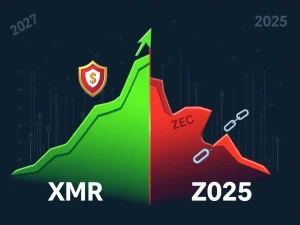Stablecoins: The Unstoppable Rise as Internet’s Default Settlement Layer

Are you ready for a financial revolution? The digital landscape is shifting dramatically, and **stablecoins** are at the forefront, quietly becoming the bedrock of internet commerce. Forget traditional payment giants; a new era of online transactions is here, promising speed, efficiency, and global reach like never before. This isn’t just a prediction; it’s a reality unfolding right now, with major players acknowledging the profound impact of these digital assets.
Stablecoins: The Backbone of a New Financial Era
In a world increasingly reliant on digital transactions, the efficiency of money movement is paramount. According to Noam Hurwitz, head of engineering at Alchemy, **stablecoins** have seen “explosive” adoption, cementing their role as the “default settlement layer for the internet.” But what exactly makes them so pivotal?
- Price Stability: Unlike volatile cryptocurrencies, stablecoins are designed to maintain a stable value, typically pegged to fiat currencies like the US dollar. This stability is crucial for everyday transactions and financial operations.
- Speed and Cost-Efficiency: Transactions settle in minutes, often with significantly lower fees compared to traditional banking or card networks, especially for cross-border payments.
- Global Accessibility: Stablecoins transcend geographical borders, enabling anyone with an internet connection to send and receive value without intermediaries.
- Security: Built on blockchain technology, stablecoin transactions benefit from cryptographic security and transparency.
These inherent advantages are why major companies are not just observing but actively integrating stablecoins into their operations, signaling a decisive shift in how money moves online.
Revolutionizing Internet Payments: Beyond Traditional Rails
The notion of **internet payments** is undergoing a profound transformation. For years, Visa and Mastercard have dominated online transactions, but a new contender has emerged. Hurwitz revealed that stablecoins have already surpassed these traditional networks in onchain transaction volume by a significant 7%. This isn’t just a marginal gain; it’s a clear indication of a paradigm shift.
Companies like PayPal and Stripe are leading this charge, actively integrating stablecoins to leverage onchain infrastructure. Alchemy, a key infrastructure provider, plays a central role in this evolution, powering stablecoin flows for fintech giants including Visa (in their crypto initiatives), Stripe, Circle, PayPal, and even supporting Robinhood Wallet.
This integration means businesses and consumers can benefit from:
- Faster settlement times for online purchases and transfers.
- Reduced transaction costs, particularly for international dealings.
- Enhanced transparency of transactions on a public ledger.
The move by these established players validates the growing maturity and reliability of stablecoin technology for mainstream financial applications.
Unpacking the Onchain Volume Surge: A New Scale of Finance
The surge in **onchain volume** for stablecoins isn’t just about surpassing traditional networks; it reflects a massive underlying financial ecosystem. This volume is driven by various use cases, from retail payments to institutional finance. One of the most striking examples of this scale is Tether (USDT), the largest stablecoin by market capitalization.
Tether’s operations are so vast that it has become a significant holder of US Treasurys, accumulating around $113 billion in US debt and generating $13 billion in profits last year alone. To put this into perspective, Tether holds more US Treasurys than entire countries like Germany. This illustrates the immense financial power and trust being placed in tokenized assets.
Hurwitz emphasized that “tokenized money is the base of the tokenized financial system,” highlighting that stablecoins are foundational to the exciting financial innovation we are witnessing. This includes everything from decentralized finance (DeFi) protocols to new forms of digital asset trading, all underpinned by the efficiency and stability that stablecoins provide.
The Expanding Horizon of Crypto Payments and Institutional Adoption
The utility of **crypto payments** extends far beyond simple peer-to-peer transfers. Stablecoins are rapidly becoming the preferred rails for a diverse range of applications:
- Cross-Border Payments: Their speed and low cost make them ideal for international remittances and business transactions, bypassing slow and expensive traditional correspondent banking networks.
- Prediction Markets: Platforms like Polymarket leverage stablecoins for efficient and transparent betting and forecasting.
- Institutional Finance: Even traditional financial giants are exploring tokenized assets. JP Morgan’s Kinexys, a permissioned deposit token, is a prime example. This innovation allows institutional clients to access yield-bearing deposits on a public blockchain with 24/7 settlement and near real-time liquidity, showcasing the potential for traditional finance to integrate with blockchain technology.
Despite this optimistic outlook, challenges remain. The fragmented blockchain landscape can complicate institutional adoption, requiring careful assessment of provider reliability and counterparty risks. The question arises: “Can a small startup really support enterprise-grade operations while building and scaling the services they need?” This highlights the need for robust infrastructure providers like Alchemy to bridge the gap between nascent technology and enterprise demands.
Digital Currency Regulation and the Future Landscape
The growing interest in **digital currency** has spurred regulators worldwide to provide clarity and oversight. A significant milestone in the US was the recent passage of the Guiding and Establishing National Innovation for US Stablecoins, or GENIUS Act, by the US Senate. This landmark bill establishes federal guardrails for stablecoins, a move welcomed by industry participants.
Hurwitz noted that “With the recent passage of the Genius Act, the regulatory landscape is becoming clearer and more structured, which benefits established financial players while also encouraging innovation.” This clarity is crucial for fostering greater institutional adoption and public trust.
Looking ahead, the future of stablecoins involves addressing technical bottlenecks to improve developer and end-user experience. While companies benefit immensely from settling on crypto rails, they often seek to “decouple the user experience from the underlying technology.” This requires deep technical expertise to create seamless, intuitive interfaces.
Hurwitz anticipates that most financial services will eventually deploy their own blockchains, especially Layer 2 networks, to better scale and monetize their ecosystems. Infrastructure improvements are expected to drive “seamless cross-chain interoperability” between these networks, leading to a more connected and efficient financial system built on stablecoins.
A Contrarian View: The BIS Perspective
While the momentum behind stablecoins is undeniable, not all institutions share the same optimistic view. A recent Bank for International Settlements (BIS) Annual Economic Report 2025 challenged the notion that stablecoins can fully serve as money in a modern financial system. The BIS report claims stablecoins fail critical singleness, elasticity, and integrity tests, describing them as “digital bearer instruments” that resemble financial assets more than actual money.
This perspective highlights ongoing debates and the complex nature of integrating novel digital assets into established financial frameworks. However, the market’s adoption trends suggest that practical utility often outpaces theoretical reservations.
Conclusion: Stablecoins as the Foundation of Tomorrow’s Internet Economy
The evidence is clear: **stablecoins** are rapidly evolving from niche crypto assets into fundamental components of the global financial infrastructure. Their ability to facilitate cheap, fast, and secure transactions across borders has positioned them as the preferred settlement layer for a growing number of businesses and individuals. From enabling major fintech companies to facilitating massive cross-border flows and even influencing national debt markets, stablecoins are demonstrating their transformative power.
Despite regulatory nuances and technical hurdles, the trajectory points towards a future where digital currencies underpin a more efficient, interconnected, and accessible internet economy. As innovation continues and regulatory frameworks mature, stablecoins are poised to redefine how we transact, invest, and interact with money online, solidifying their unstoppable rise as the true backbone of the internet’s financial future.









